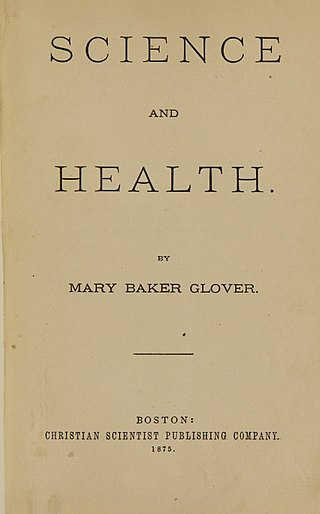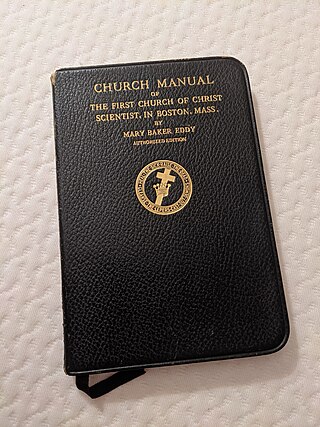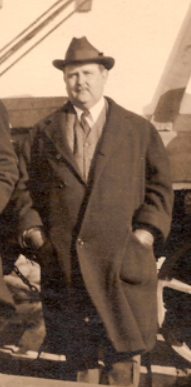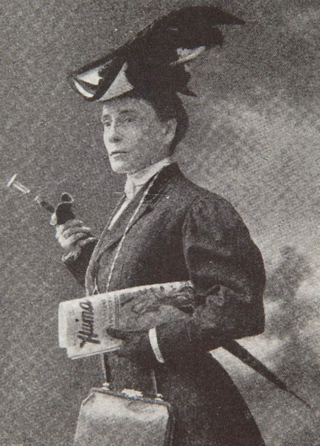
The Church of Christ, Scientist was founded in 1879 in Boston, Massachusetts, by Mary Baker Eddy, author of Science and Health with Key to the Scriptures, and founder of Christian Science. The church was founded "to commemorate the word and works of Christ Jesus" and "reinstate primitive Christianity and its lost element of healing".

Science and Health with Key to the Scriptures by Mary Baker Eddy is, along with the Bible, one of the two central texts of the Christian Science religion. Eddy described it as her "most important work". She began writing it in February 1872, and the first edition was published in 1875. However, she would continue working on it and making changes for the rest of her life.

Mary Baker Eddy was an American religious leader and author who founded The Church of Christ, Scientist, in New England in 1879. She also founded The Christian Science Monitor in 1908, and three religious magazines: the Christian Science Sentinel, The Christian Science Journal, and The Herald of Christian Science. She wrote numerous books and articles, the notable of which were Science and Health with Key to the Scriptures and Manual of The Mother Church. Other works were edited posthumously into the Prose Works Other than Science and Health.

Christian Science is a set of beliefs and practices which are associated with members of the Church of Christ, Scientist. Adherents are commonly known as Christian Scientists or students of Christian Science, and the church is sometimes informally known as the Christian Science church. It was founded in 1879 in New England by Mary Baker Eddy, who wrote the 1875 book Science and Health with Key to the Scriptures, which outlined the theology of Christian Science. The book became Christian Science's central text, along with the Bible, and by 2001 had sold over nine million copies.

Bliss Knapp, the son of Ira O. and Flavia S. Knapp, students of Mary Baker Eddy, was an early Christian Science lecturer, practitioner, teacher and the author of The Destiny of the Mother Church.

The Christian Science Publishing Society was established in 1898 by Mary Baker Eddy and is the publishing arm of The First Church of Christ, Scientist in Boston, Massachusetts.
A Christian Science practitioner is an individual who prays for others according to the teachings of Christian Science. Treatment is non-medical, rather it is based on the Bible and the Christian Science textbook, Science and Health with Key to the Scriptures (1875) by Mary Baker Eddy (1821–1910), who said she discovered Christian Science in 1866 and founded the Christian Science church in 1879. According to the church, Christian Science practitioners address physical conditions, as well as relationship or financial difficulties and any other problem or crisis.

The Church Manual of The First Church of Christ, Scientist, in Boston, Massachusetts commonly known as the Manual of The Mother Church is the book that establishes the structure and governance of The First Church of Christ, Scientist, also known as The Mother Church, functioning like a constitution. It was written by Mary Baker Eddy, founder of the church. It was first published in 1895 and was revised dozens of times. The final edition, the 89th, was published in 1910.
Robert Arthur Peel was a Christian Science historian and writer on religious and ecumenical topics. A Christian Scientist for over 70 years, Peel wrote editorials for the Christian Science Monitor, a publication owned by the Church of Christ, Scientist. He was also a counsellor for the church's Committee on Publication, set up by Mary Baker Eddy (1821–1910), the religion's founder, to protect her own and the church's reputation.

Josephine Emma Curtis Hopkins was an American spiritual teacher and leader. She was involved in organizing the New Thought movement and was a theologian, teacher, writer, feminist, mystic, and healer; who taught and ordained hundreds of people, including notably many women. Hopkins was called the "teacher of teachers" and "mother of New Thought" because a number of her students went on to found their own churches or to become prominent in the New Thought Movement, including Charles and Myrtle Fillmore, founders of Unity Church; Ernest Holmes; and H. Emilie Cady, author of Unity's cornerstone text Lessons in Truth. According to Charles S. Braden, Hopkins influenced the development of New Thought "more than any other single teacher", and modern scholars have identified Hopkins as the founder of New Thought.

Septimus James Hanna, an American Civil War veteran and a judge in the Old West. He was a student of Mary Baker Eddy, who founded the Christian Science church. Giving up his legal career, he became a Christian Science practitioner, lecturer and teacher. Hanna occupied more leading positions within the church organization than any individual, serving as pastor, then First Reader of The Mother Church, as editor and associate editor of the periodicals, member of the Bible Lesson Committee, he served two terms as president of The Mother Church, he was teacher of the Normal (teachers) Class of 1907, later vice president and then president of the Massachusetts Metaphysical College.

Eschatology is a New Thought movement founded by American writer and former practitioner William W. Walter. Walter was formally a member of the Catholic Church and then The First Church of Christ, Scientist until 1912 when he rejected organized religion in order to found his own metaphysical system. Although it is generally classified as a new religious movement, Walter did not see it as a religious movement, and his followers reject the association with religion. He originally named his organization "The Walter Method of Christian Science"; and the term Eschatology as a trademark for Walter's teaching was not used until the 1920s.

Augusta Emma Stetson was an American religious leader. Known for her impressive oratory skills and magnetic personality, she attracted a large following in New York City. However, her increasingly radical theories, conflicts with other church members including a well-known rivalry with Laura Lathrop, and attempts to supplant Mary Baker Eddy as the leader of The First Church of Christ, Scientist, led to her eventually being excommunicated from the church on charges of insubordination and of false teaching. Afterwards she began preaching and publishing various works on her theories which she named the "Church Triumphant," and started a controversial radio station to advance her cause.

The Life of Mary Baker G. Eddy and the History of Christian Science (1909) is a highly critical account of the life of Mary Baker Eddy, the founder of Christian Science, and the early history of the Christian Science church in 19th-century New England. It was published as a book in November 1909 in New York by Doubleday, Page & Company. The original byline was that of a journalist, Georgine Milmine, but a 1993 printing of the book declared that novelist Willa Cather was the principal author; however, this assessment has been questioned by more recent scholarship which again identifies Milmine as the primary author, although Cather and others did significant editing. Cather herself usually wrote that she did nothing more than standard copy-editing, but sometimes that she was the primary author.

Rev. Irving Clinton Tomlinson was an American Universalist minister who converted to Christian Science, becoming a practitioner and teacher. For a time, he lived as one of the workers in the household of church founder, Mary Baker Eddy, later writing a book about his experiences called Twelve Years with Mary Baker Eddy.

Annie MacMillan Knott was a practitioner and teacher in The First Church of Christ, Scientist. She was a student of Mary Baker Eddy, the founder of the religion, and served the church in various capacities including First Reader, Associate Editor of the Christian Science periodicals, member of the Bible Lesson Committee, one of the first women on the Christian Science Board of Lectureship, Trustee under the Will of Mary Baker Eddy, and the first woman to become a member of the Christian Science Board of Directors.

John Valentine Dittemore was director of The First Church of Christ, Scientist, the Christian Science church, in Boston from 1909 until 1919. Before that he was head of the church's Committee on Publication in New York, and a trustee for ten years of the estate of Mary Baker Eddy (1821–1910), the founder of the church. Dittemore is best known as the co-author, with Ernest Sutherland Bates, of Mary Baker Eddy: The Truth and the Tradition (1932).

Sibyl Wilbur O'Brien Stone, best known as Sibyl Wilbur, was an American journalist, suffragist, and author of a biography of Mary Baker Eddy. She was a San Diego Branch Member of the National League of American Pen Women and a member of the New England Woman's Press Association.

Adam Herbert Dickey, was an author, member of the Board of Directors of The First Church of Christ, Scientist, and a secretary to Mary Baker Eddy.
The Christian Science movement is a religious movement within Christianity founded by Mary Baker Eddy that arose in the mid to late 19th century and that led to the founding of The First Church of Christ, Scientist.

















